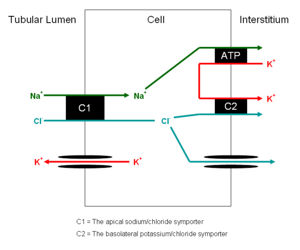Reabsorption and Secretion Along the Distal Tubule and Collecting Duct - Anatomy & Physiology
|
|
Distal Tubule
- Important site of regulation of ions and water
- Less emphasis on bulk transport compared with proximal tubule
- More emphasis on fine management
- It is able to do this as it has high resistance epithelia. Allowing it to maintain substantial gradients across it
- Very important for the homeostasis of:
- There are two cell types present each with different functions. They are similar to the cells of the collecting ducts
- Principal cells
- Absorb sodium
- Excrete potassium and hydrogen
- Site of action of Aldosterone
- Intercalated cells
- ATP driven proton secretion
- Principal cells
Juxtaglomerular Apparatus
- The terminal portion of the straight distal tubule contacts the afferent and efferent vessels supplying its own glomerulus
- These vessels are said to embrace the distal tubule
- Here a special apparatus called the Juxtaglomerular Apparatus has 3 different structures:
- The tubular epithelial cells of the distal tubule which are in contact with the arterioles supplying the glomerulus of that nephron are called the macula densa. They play a vital role in the regulation of the GFR.
- The Juxtaglomerular Cells are smooth muscle cells which adjoin the macula densa in the capillary wall.
- The Extraglomerular Mesangium has an unclear function
Developmental
Develops from metanephric tubule

